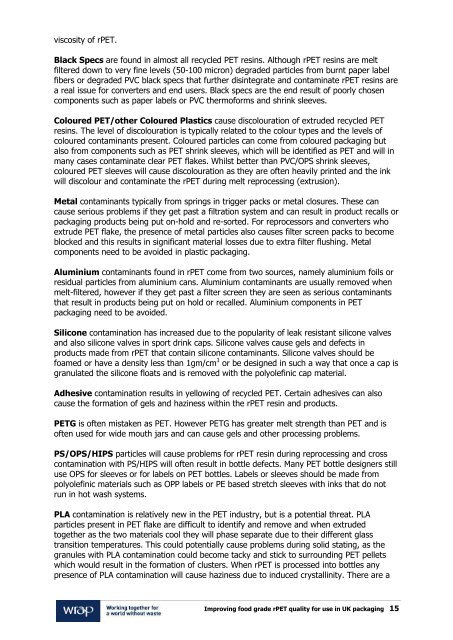rPET Quality Report
You also want an ePaper? Increase the reach of your titles
YUMPU automatically turns print PDFs into web optimized ePapers that Google loves.
viscosity of <strong>rPET</strong>.<br />
Black Specs are found in almost all recycled PET resins. Although <strong>rPET</strong> resins are melt<br />
filtered down to very fine levels (50-100 micron) degraded particles from burnt paper label<br />
fibers or degraded PVC black specs that further disintegrate and contaminate <strong>rPET</strong> resins are<br />
a real issue for converters and end users. Black specs are the end result of poorly chosen<br />
components such as paper labels or PVC thermoforms and shrink sleeves.<br />
Coloured PET/other Coloured Plastics cause discolouration of extruded recycled PET<br />
resins. The level of discolouration is typically related to the colour types and the levels of<br />
coloured contaminants present. Coloured particles can come from coloured packaging but<br />
also from components such as PET shrink sleeves, which will be identified as PET and will in<br />
many cases contaminate clear PET flakes. Whilst better than PVC/OPS shrink sleeves,<br />
coloured PET sleeves will cause discolouration as they are often heavily printed and the ink<br />
will discolour and contaminate the <strong>rPET</strong> during melt reprocessing (extrusion).<br />
Metal contaminants typically from springs in trigger packs or metal closures. These can<br />
cause serious problems if they get past a filtration system and can result in product recalls or<br />
packaging products being put on-hold and re-sorted. For reprocessors and converters who<br />
extrude PET flake, the presence of metal particles also causes filter screen packs to become<br />
blocked and this results in significant material losses due to extra filter flushing. Metal<br />
components need to be avoided in plastic packaging.<br />
Aluminium contaminants found in <strong>rPET</strong> come from two sources, namely aluminium foils or<br />
residual particles from aluminium cans. Aluminium contaminants are usually removed when<br />
melt-filtered, however if they get past a filter screen they are seen as serious contaminants<br />
that result in products being put on hold or recalled. Aluminium components in PET<br />
packaging need to be avoided.<br />
Silicone contamination has increased due to the popularity of leak resistant silicone valves<br />
and also silicone valves in sport drink caps. Silicone valves cause gels and defects in<br />
products made from <strong>rPET</strong> that contain silicone contaminants. Silicone valves should be<br />
foamed or have a density less than 1gm/cm 3 or be designed in such a way that once a cap is<br />
granulated the silicone floats and is removed with the polyolefinic cap material.<br />
Adhesive contamination results in yellowing of recycled PET. Certain adhesives can also<br />
cause the formation of gels and haziness within the <strong>rPET</strong> resin and products.<br />
PETG is often mistaken as PET. However PETG has greater melt strength than PET and is<br />
often used for wide mouth jars and can cause gels and other processing problems.<br />
PS/OPS/HIPS particles will cause problems for <strong>rPET</strong> resin during reprocessing and cross<br />
contamination with PS/HIPS will often result in bottle defects. Many PET bottle designers still<br />
use OPS for sleeves or for labels on PET bottles. Labels or sleeves should be made from<br />
polyolefinic materials such as OPP labels or PE based stretch sleeves with inks that do not<br />
run in hot wash systems.<br />
PLA contamination is relatively new in the PET industry, but is a potential threat. PLA<br />
particles present in PET flake are difficult to identify and remove and when extruded<br />
together as the two materials cool they will phase separate due to their different glass<br />
transition temperatures. This could potentially cause problems during solid stating, as the<br />
granules with PLA contamination could become tacky and stick to surrounding PET pellets<br />
which would result in the formation of clusters. When <strong>rPET</strong> is processed into bottles any<br />
presence of PLA contamination will cause haziness due to induced crystallinity. There are a<br />
Improving food grade <strong>rPET</strong> quality for use in UK packaging 15



